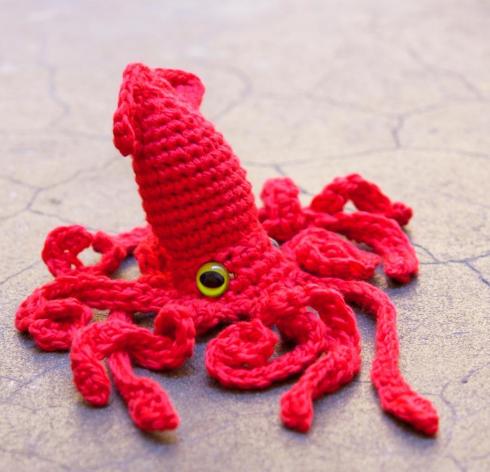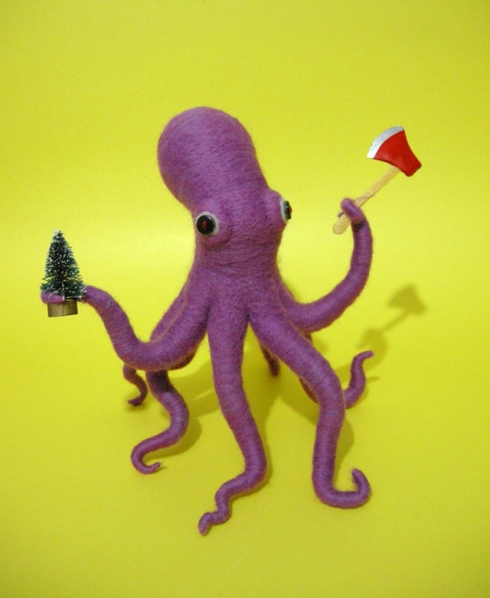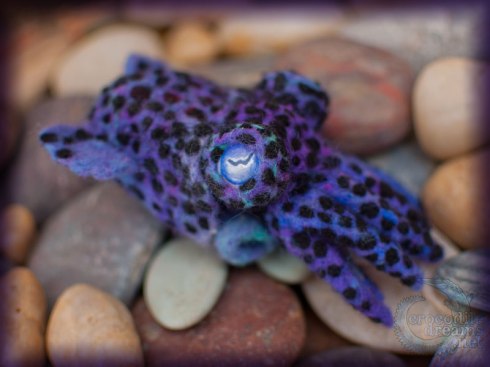You are currently browsing the tag archive for the ‘Squid’ tag.

Once again Ferrebeekeeper plunges into the abyssal depths of the ocean seeking a bizarre and barely known cephalopod—the elbow squid. Elbow squid, also colloquially known as “bigfin squid” are deep sea squid of the genus Magnapinna. Although they have been known to science since at least 1907 when a juvenile specimen was found and categorized, the strange animals are a real enigma to scientists. No adult specimens were known until the 1980s and only in the cotemporary era of widespread deep-sea robots were pictures of the living animals obtained.

But WHAT pictures! These images were worth the wait: of all Earth creatures which are not microbes, the elbow squid may well be the most unfamiliar and alien in appearance. Indeed, I have seen plenty artist’s conceptions of extraterrestrial life and precious few looked as bizarre as the elbow squid. The animals have extremely long tentacles which dangle at right angles from 10 upper arms (which project at right angles from the squid’s cylindrical body. The visual impact of this crazy arrangement is even more dramatic than it sounds.

Shell oil used a submersible robot to film a specimen hanging around their deep water oil platform “Perdido” (which is 200 miles offshore from Houston in the Gulf of Mexico) and the squid’s tentacles were reliably 9 to 10 meters (26-30 feet) long. These animals are different from giant squid—but they are also giant squid.
So why on Earth do elbow squid have such long arms? We simply do not know. Some scientists speculate that it brushes along the ocean bottom gathering up sluggish meals with its long arms. Other mollusk theorists(?) think it is like a brittle starfish and lies on the bottom as the tentacles write around. Yet another school believes the ten tentacles are for active predatory grabbing—the squid is like a fisherman with ten lassos. Perhaps it combines these and other behaviors. Other cephalopods are well known for being versatile and clever.
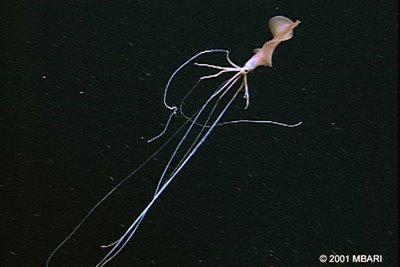
I would love to tell you about the hopes and fears of this strange denizen of the deeps. What animals prey on it (Sperm whales and elephant seals presumably, but what else?)? What is its love life like? How long do they live? But we don’t even know what these things eat. How it would fill out a Zoosk profile is particularly beyond our kin. The elbow squid is at the tantalizing juncture between the known and the unknown. Undoubtedly we will learn more, but for now we will just have to be content that we have seen them at all.

Ordovician(by mirelai from Deviant Art)
In a long-ago post, Ferrebeekeeper wrote about the Ordovician–the age of mollusks–when big predatory cephalopods and gastropods overtopped nascent vertebrates as the apex predators of the world oceans. Cephalopods are fiercely intelligent, incredibly fast, and astonishing at camouflage. They can be infinitesimally small or remarkably large. They can even be transparent. However they don’t last well—they are squishy and even if they aren’t eaten they have very short lives. One of the most vivid memories of my adolescence was watching cuttlefish hover and change colors and feed with bullet-fast grabber arms at the National Zoo. The memory comes with a dark post-script. I returned a few months later with friends, only to find that the cuttlefish had entered a bizarre unnatural senescence and were literally falling apart at the seams. They do not die of old age in the ocean; something always eats them.

But this is no longer the lovely Holocene with its oceans full of fish and skies full of birds. We have entered the Anthropocene—an age of hot acid oceans filled with Japanese trawlers bent on catching every last fish in the sea by means of nets the size of Rhode Island. Suddenly it is not so beneficial to be a big bony ancient fish with hard scales and sharp teeth. The teleosts and the cartilaginous fish are being physically pulled out of the ocean by humans. It takes them too long to reproduce and rebuild their numbers (even as national governments subsidize fishermen to build more and larger fishing boats). The age of fish—which has lasted from the Devonian (420 million years ago) until now—is ending. So a new scramble to exploit the great open niches in the seas is beginning.

Unexpected life forms are flourishing. The sea floors are filling up with lobsters, which have not been so prevalent in a long time. Giant jellyfish are appearing in never-before-seen numbers. However it is beginning to seem like the greatest beneficiaries may be the cephalopods. Mollusks with shells are having their own troubles–as the carbonic acid oceans eat at their calcium shells, but the octopus, squid, and cuttlefish have no such problems. Not only are they well suited for tropical waters, they rcan also reproduce so fast that they can keep ahead of human’s bottomless appetite. A single squid egg cluster can have millions of eggs inside.

Cephalopods tend to be generalists—they eat all sorts of things including booming micro-invertebrates and jellyfish. They are clever enough and malleable enough to slip out of all sorts of hazards. Their swift lives are a boon. Because they reproduce so quickly and prolifically, they evolve quickly too—a necessity in our 24 hour world (as all sorts of out-of-work journalists, lamp lighters, factory workers, and saddlemakers could tell you). I wonder if in a few million years the waters will glow with great shoals of exotic tentacle beasts we have scarcely imagined. Will there be fast marlin-type squids with rapiers on their mantles and huge whale-shark type octopuses skimming the phytoplankton with their own giant nets? Will the skies darken with flying squids and the sea floor change colors as tens of thousands of cuttlefish take the roles of reef fish and reef alike?

Hawaiian bobtail squid (image from forums.furcadia.com)
It is possible. The world is changing faster than we would like to admit—becoming something brand new—becoming something very old.
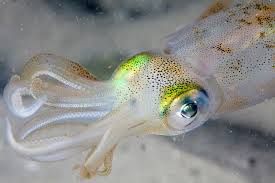

Taningia danae
This is Taningia danae, the Dana octopus squid. CNN featured a video of one filmed by some sort of submersible off the coast of Hawaii and I thought I would look up the animal and write about it (since the short CNN video contained almost no information…and was bookended by obnoxious ads for IBM office services and dubious stomach medicine). The squid is a member of the family Octopoteuthidae, a group of pelagic and benthic photoluminescent squid (although some taxonomists question whether the family is valid). Although Taningia danae is not as gigantic as the colossal squid or the giant squid, it is still a very large creature: specimens have been caught which weigh up to 161.4 kilograms (356 pounds) and with a length of 2.3 m (7.5 feet). These highly intelligent and maneuverable squid sometimes hunt together like wolf packs. They live on fish and smaller squids of the mid-ocean depths and are preyed on by large powerful marine mammls like sperm whales.
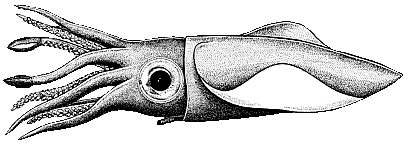
The squid makes use of intense photoluminescent arm tips for hunting, measuring distance, and communicating with others of its kind. It can emit a brilliant strobe-like flash to stun prey, but it also uses the flashes for mating displays. The squid in the video endearingly came up and hugged the glowing submersible…although maybe that is an unduly cheerful interpretation. Being hugged by an 8-armed sea monster that weighs as much as a linebacker might be less endearing than advertised.

An actual photograph of the businees end of T. danae (Image: Tsunemi / Proc. Roy. Soc. B)
It has been a long time since we had a mollusk post, so today let’s enjoy a post about squid, octopuses, and extinct nautiloids…and knitting. Apparently the characteristic tubes and whorls formed by knitting can be easily adapted to produce lovely tentacled plush characters. Sadly, I am a terrible knitter (or, more accurately, not a knitter) but I appreciate the art. Also, as a toy maker I have a professional interest in these plush toys, even if they are not necessarily in my own area of specialty.
Look at how cute the squids and extinct cephalopods are. Some of these designs are truly ingenious, like the red squid at the top, or the belemnites immediately below. I wish I had had some of these as a child to pair with my beloved dinosaur stuffed animals and toys. When I was young, I was unhappy that it was so difficult to get toys of prehistoric ocean creatures other than plesiosaurs (and frankly even those were hard to come by). Even if it is still hard to get mass-produced orthocones and ammonites, these beautiful hand-made pieces certainly help fill the gap. Now your plush ichthyosaur will have something to predate! Or, if your toy collection is more modern, you will have the right character for stinging the Australian PM.
I wish I could tell you more about how these are made and where you could get the patterns, but it seems like a certain expertise in the textile arts is required. I only know the difference between what is felted and what is knitted. My mother, however, has a lovely yarn store in Parkersburg, West Virginia and she is an expert at every aspect of knitting, crocheting, weaving, and sewing. I am sure she could explain to you how to make any of these creatures (or any other lovable knitted or felted animal toys)…provided you bought the yarn from her store.
Aren’t these all adorable. They make me want to get back into toy making and create “My Little Squiddy.”

Too late…here are the “My Little Cephalopod” series of “My Little Pony” Themed Squid Plushies (from Laughing Squid)
OK…today features two more wacky sketches from my little book. I promise I will have a different topic tomorrow and not keep putting up these oddities! Here is a children’s soccer game which I drew in a park in Chinatown in spring. I wish I had captured the NY Chinatown flavor of the afternoon better—there was a very strange older lady loudly singing idiosyncratic songs in Chinese and passing out leaflets while two older gentlemen accompanied her on traditional musical instruments. However whenever I chanced to look in their direction, they certainly noticed, and sketching them was out of the question. Don’t worry, I gave them a few coins for the serenade and they seemed delighted!
I also drew the peculiar chemical factory innards of a mysterious shamanistic beast. Unfortunately I don’t really know what else to say about the surreal little pastiche…but it certainly features a jaunty-looking squid (although my favorite part is the magenta sky filled with ephemera).
We’ll get back to history, crowns, and/or furry beasts tomorrow!
According to 1000 Symbols by Rowena and Rupert Shepherd, “Aborigines in the Wessel Islands of Australia’s Arnhem Land regard the squid as a healer. In their ancestral mythology, the female squid is believed to have created all the features of the landscape and the local family clans. The male squid then divides the land among the clans.” I could not find any other information about this myth, but I did discover the beautiful linocut above by Joel Sam–a Torres Strait Islander artist, raised in Bamaga, Cape York. I thought the print captured the spirit of the creator squid.
In geometry class back in secondary school, there was one happy day, at least—the day we talked about the rhombus. The rhombus is a parallelogram in which the angles of the opposite sides are equal: diagonals drawn through the center of these angles will intersect each other at right angles in the center of the rhombus (see fig. 1). It is a beautiful shape with a stylish name that everyone started saying in amused wonder. Meanwhile, off the coast of Cuba or Tenerife or Okinawa, divers sometimes chance upon a mysterious human-sized blob of diaphanous pink gelatin composed of delicate loops of exquisite pink spheres. What is the connection between these disparate stories?
The pink alien blobs floating in the tropical and semi tropical seas of the world are the work of Thysanoteuthis rhombus, a.k.a. the diamond squid (which completely sounds like a crime boss name). The species is actually quite large for an invertebrate and some individuals can grow up to a meter (3 feet) in length and mass up to 30 kilograms (66 pounds). Thysanoteuthis rhombus is named for its huge fins which run along the entirety of its mantle and give it the appearance of a rhombus. If you draw diagonals through the center of its angles they would probably intersect at right angles too (although you shouldn’t do this in the real world since T. rhombus is a tremendous swimmer with ten strong tentacle arms–including two extra-long club arms covered with extra-rows of tentacles for grabbing prey or fighting).
Diamondback squid jet through the warm parts of the oceans in pairs and tiny schools hunting for swift and intelligent fish. They in turn are hunted by some of nature’s most fearsome predators: cetaceans, sharks, and the Japanese.
 The squid hunt near the surface at night, and retreat to middle depths during the day. Somewhat uncharacteristically, they have no bioluminescence. The large enigmatic pink blobs I mentioned are their eggs. Once the female is fertilized, she lays a vast helix of eggs which are embedded in a stickly translucent line. These egg clusters look like salps or siphonophores (or extraterrestrials) but they are actually thousands of diamond squid eggs. When they hatch, they become adorable larval squid which head off into the phytoplankton to hunt.
The squid hunt near the surface at night, and retreat to middle depths during the day. Somewhat uncharacteristically, they have no bioluminescence. The large enigmatic pink blobs I mentioned are their eggs. Once the female is fertilized, she lays a vast helix of eggs which are embedded in a stickly translucent line. These egg clusters look like salps or siphonophores (or extraterrestrials) but they are actually thousands of diamond squid eggs. When they hatch, they become adorable larval squid which head off into the phytoplankton to hunt.
The Cranchiidae are a family of squid commonly known as “glass squid” which live in oceans around the world. The squid are of no interest to commercial fisheries (yet) and a great deal about this family remains completely unknown. Most of the 60 known species of cranchiidae are small and inconspicuous–indeed the majority are transparent and thus nearly invisible. However the largest known mollusk, the colossal squid (Mesonychoteuthis hamiltoni), is part of the family, (so it might be wise not to antagonize them on the playground).
Glass squid are notable for having stubby swollen-looking bodies and short arms except for one long pair of hunting tentacles. The majority of glass squid have bioluminescent organs which they use to hunt, to communicate and to disguise the faint shadows cast by their transparent bodies (predators of the deep can see even the faintest shadows cast by the dim light from the surface). The cranchiid squids themselves sport a variety of interesting and complex eyes which range from giant circular eyes to stalked eyes to telescoping eyes. This little gallery shows how delicate, diverse, and beautiful (and how utterly alien) these squid can be.
Juvenile cranchiid squid are part of the plankton and live near the surface where they hunt microscopic prey while trying to avoid thousands of sorts of predators. As they mature, they change shape and descend to deeper waters—indeed some species become practically benthic and can be found more than 2 kilometeres under the ocean. Glass squid move up and down the water column by means of a fluid filled chamber which contains an ammonia solution (which maybe explains why they are not on the human menu yet).




